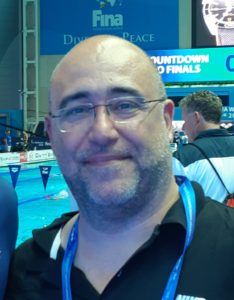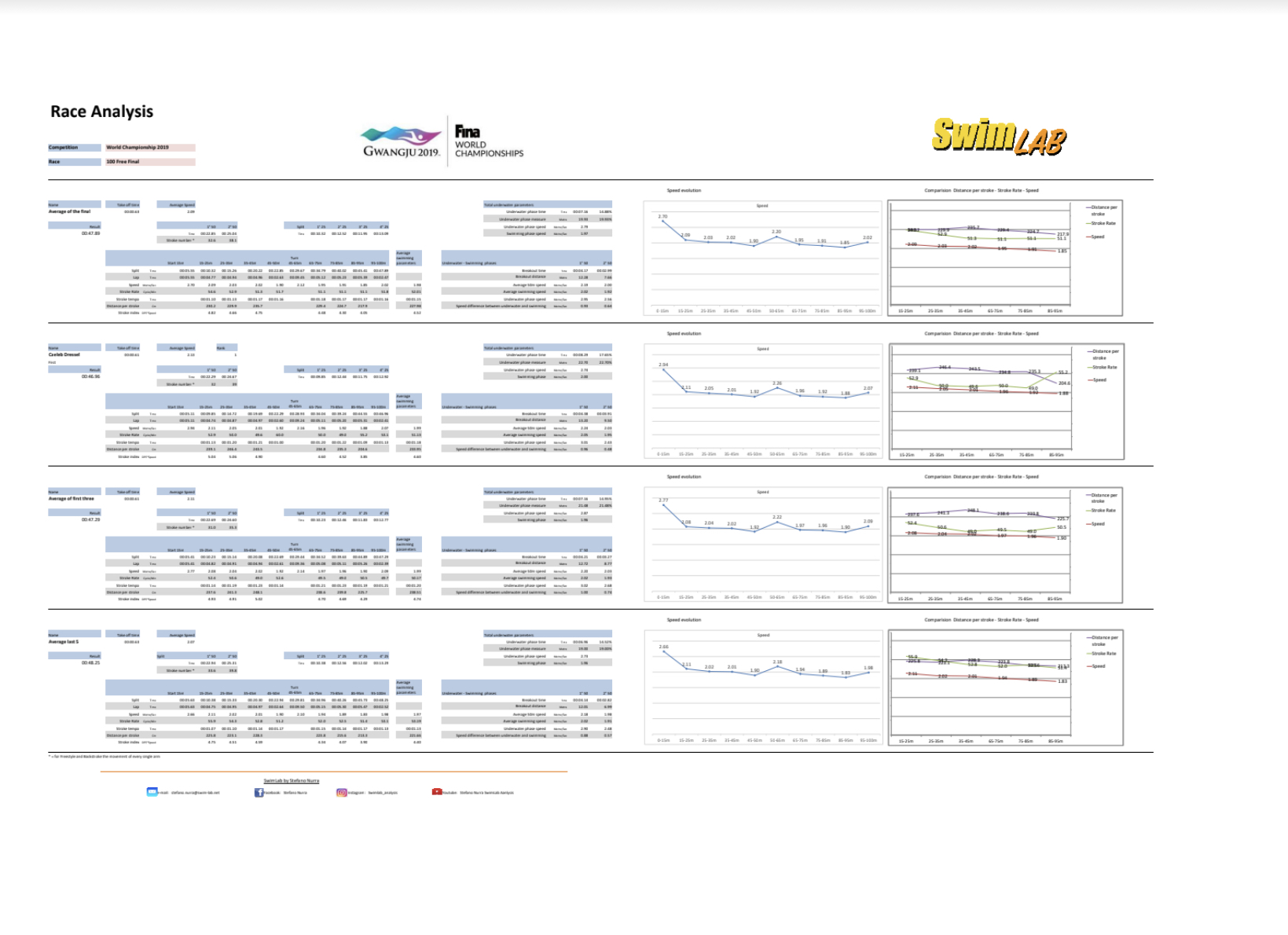As we anticipated previously, it is time to study (but in a fun way).
- To see a discussion of the information in these analyses, click here.
100m freestyle. The most important race!
Race Video (only highlights have been published for public use):
The study of the average results of the 100-meter freestyle finalists allows us to make a lot of interesting considerations.
The finalist of the men’s 100m free at the 2019 World Championship were:
- Nandor Nemeth
- Blake Pieroni
- Marcelo Chierighini
- Caeleb Dressel
- Kyle Chalmers
- Vladislav Grinev
- Clement Mignon
- Breno Correira
First of all, let’s consider the splits and laps.
The first 50-meter average is 22.85 seconds while the average time of the second half is 25.04 seconds, with a split-difference of 2.19 seconds. It is interesting to compare these data with the average time of the first three finalists and with the average time of the last five athletes. In this case the difference is 1.91 seconds for the first three and 2.37 for the last five.
- Click here for the full PDF analysis – 8 athletes
- 100 free men’s final World Championships 2019 average
The average time for the first 50m of the top 3 finishers, the medalists, is 22.69 seconds, and the average opening 50 time for places 4-8 is 22.94 seconds, with a first 50 split difference of 0.25.
For the second half the data are as follows:
- 24.60 for the first three athletes
- 25.31 for the five finalist
The difference is 0.91.
To be part of the finals, the athletes must be able to swim with an average time of 22.85, but only those who have better balance between the first and second 50 could be in the top 3 finishers.
The main difference between Dressel and all others is the first 15m. Dressel‘s time in the first 50 meters is 5.11 seconds, with a total average of the final of 5.55 while the average time of the last five finalists is 5.63 seconds.
The split off the turn is a bit faster for the first 3 athletes, but the gap is less than at the start.
From 45 meters to 65 meters (into and out of the turn), the average time of the first three swimmers is 9.36, of the last five finalists is 9.50 and for Caeleb Dressel we recorded a time of 9.24
A perceptive remark of stroke rate/tempo shows us that for the first 3 swimmers it is a bit slower than the stroke rate/tempo for the last 5 swimmers.
The distance per stroke is absolutely longer for the first 3 athletes if compared to the distance per stroke of the last five swimmers. (17cm longer as average). The power plays an important role in this situation and above all the ability to apply this power to the water.
The underwater Phase
The management of the underwater phase is interesting too. After the start the average length of the underwater phase is 12.28m, but we recorded an average length of 12.72 for the first three swimmers and of 12.01 for the last 5 athletes: this is a huge difference.
After the turn the average length of the underwater phase is 7.66m, but we recorded an average length of 8.77m for the first three athletes and of 6.99m for the last 5 swimmers.
As regards the underwater phase, the difference does not refer only to the length but also to the speed: 3.02 meter per second for the first three athletes and 2.90 for the last 5 swimmers. The first three swimmers have a more efficient underwater phase and also the difference between the underwater and swimming speed helps us to appreciate this value much more.
This shows that, while underwaters are less important in long course than in short course, they are still an incredibly important skill in the 50 meter pool.
CONCLUSION
In conclusion, the first three athletes and last five athletes differ in every single detail.
The power is the main skill necessary to swim 100m freestyle in this level, or better the ability to apply strength to the water.
This story comes courtesy of STEFANO NURRA
- Analyst of Turkish Swimming Federation
- Analyst of Energy Standard
- Owner of Swimlab


Great article! I love these kinds of detailed analysis.
100 is lame. 200 is most important race
200 is lame, the 10k is most hardcore race
I suspect that the average numbers for the first 3 swimmers are strongly affected by Dressel alone. A side-by-side comparison of Dressel and Chalmers, the two freaks in this lot, would be interesting.
Dressel first 50m vs Chalmers second 50m would be interesting…..Chalmers flys home in the last 25m….
Nice analysis! Can’t wait for when Chalmers or Dressel breaks the world record.
or both!
I hope I’m proven wrong, but I really don’t think Chalmers will be under 47.5 at Tokyo. Too many swimmers are weakened after shoulder injuries and surgeries.
Agree. It would be a great accomplishment if he could dip under 47.5, but will depend on how well the shoulder holds up in training the next couple of months.
All of your PDF links are the same.
One thing you also need to consider is the swimmers velocity and by extension momentum. Yes Dressel reaches the 15m mark first but equally important is he reaches the 15m mark at a faster speed. Swimmers are all slowing down from the start to the wall and from each wall to the next wall. If you’re holding your speed better at 15m then it’s easier to swim faster from 15m-50m and easier to flip faster.
This concept is super important for young athletes to understand early on. A simple yet eye opening drill is having an athlete do a 25 from a dive and recording their split time at the 12.5. Then having them do a mid pool 12.5… Read more »
Exactly. Like when we see someone “accelerating past the competition” we are really just seeing them not die in the race as badly as the rest of their competition.
Interesting, although I’m not sure why the data is split into first 3 and last 5. You’ve got Dressel in the first 3, who is going to skew a sample set of that size. He spends much more time underwater than most swimmers in a 100 freestyle (including the other guys on the podium).
I agree. Caeleb’s start and underwaters are far beyond any other sprinter, not just the top 3.